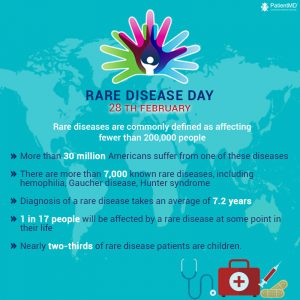Rare diseases often skip the attention of the general public as it affects a lesser number of population. But is incidence of rare disease that much rare actually? While US government marks one disease as rare if it affects lesser than 1 in 200,000 individuals in the population, Europe recognizes a disease as rare if it affects less than 1 in 2000 individuals . There is no standard norm to define a rare disease, but few disorders show variances among population levels. Thus one disease common in a part of globe may be defined as rare in another country.

Few startling facts:
Globally , around 30 million people are suffering from rare diseases.In many cases they are living in life threatening or chronically debilitating conditions.
The estimates of rare diseases appearing in different parts of the world are pegged between 6000-8000 diseases.
Nearly 80% of these diseases are not incidental. Those are genetically transmitted to the next generations.
More than 50% of the diseases affect children.
Death is not rare for rare diseases. Nearly 30% of the population that die out of these diseases are below the age of five.
Diagnostic challenges:
- The most common hindrances for accurate diagnosis of the rare disease is ignorance. It is seen that in an average, the patient may visit 7 physicians and the mean time of accurate diagnosis of the disease from symptom onset is around 4.8 years. Many patients die ( especially children) within this timeframe before any treatment ( if available) or effective disease management is initiated .
- The main reasons behind diagnostic delay may be attributed to reasons like:
- Limited awareness about the disease among patients, families and most important among physicians.
- Often the onset of the disease is marked with minor, generalized complications and common illnesses mask the precise symptoms.Only when the general treatment fails, it makes the doctor suspicious and investigation about chances of a rare disease is initiated.
- In several cases , one patient having a particular rare disease may be the first case for a doctor to encounter. The huge variety of rare disease types ( c.a. 7000) makes it impossible for a physician to remain aware about all possibilities.
Impact of delayed diagnosis to patients:
- Late diagnosis leads to delayed treatment.
- Often delay in diagnosis leads to improper management of the patients while there is a steady progress of the disease internally.
- Misdiagnosis is common and it may lead to improper management and additional interventions may be provided which may be actually inappropriate for the underlying disorder.
- Lack of improvement in misdiagnosed cases frustrates the patients and families and they keep shifting from one doctor to another and thus making the diagnosis and proper treatment initiation even more delayed. Often it is too late when the actual diagnosis is done.
Early diagnosis dramatically improves the chances of effective cure and management
Its most important to have an accurate and early diagnosis of the rare diseases.
Prediction of chances of acquiring such disorders may form the most important foundation of disease management .
Raising awareness and recognition of rare diseases are also very important to empower patients and caregivers.
Personalized medicine is the mode of choice
“The most of the medications are made for the mass, while personalized medicines aim for every class!”
There can be various aspects where the latest developments in science may help:
- The Next generation based sequencing attempt at finding genetic disorders at fine details for an individual, and thus now it is possible to correlate the symptoms if there is a genetic origin. These molecular testing procedures are often non-invasive and may be tested from the convenience of the homes too.
- Genetic tests may:
- Confirm the presence of a disease
- Indicate if a disease may occur in later part of the life for the healthy individual with high accuracy of prediction
- May help in identification the other family members who are also susceptible to the same disease and thus making the management possible for other unsuspecting patients .
- A genetic test early in life may help one to remain aware of chances of acquiring the disease and pay proper attention to even minor symptoms to start the disease management at the right moment.
PatientMD is committed to help in management of rare diseases:
We feel that “prevention is the first step to cure!”
The future of medicine lies in a personalized approach to an individual rather than treating one as a part of group of patients. NGS based genetic tests may decipher even single nucleotide variations among the nearly 3.3 billion bases of DNA that we inherit. This , when applied for an individual, may provide useful insights into his personal health profile and we may understand how that variation may make one susceptible to a disease including rare diseases. By looking at the genes and pathways affected , we may try to understand how a metabolic process of the person is affected that makes one prone to a disease. This will lead to specifying individualized disease management plans.
That day is coming near when a rare disease will rarely be remaining undetected.
Few important resources to learn about rare diseases:
- National Organization for Rare Disorders ( NORD) : ( https://rarediseases.org)
- Genetics And Rare Diseases information Center ( GARD) : https://rarediseases.info.nih.gov/diseases
- Organization for rare Diseases India ( ORD): https://ordindia.org/
- Genetic and rare disease network (GARD): https://gardn.org.au/
Leave a Reply